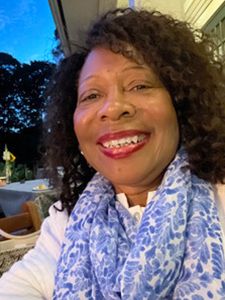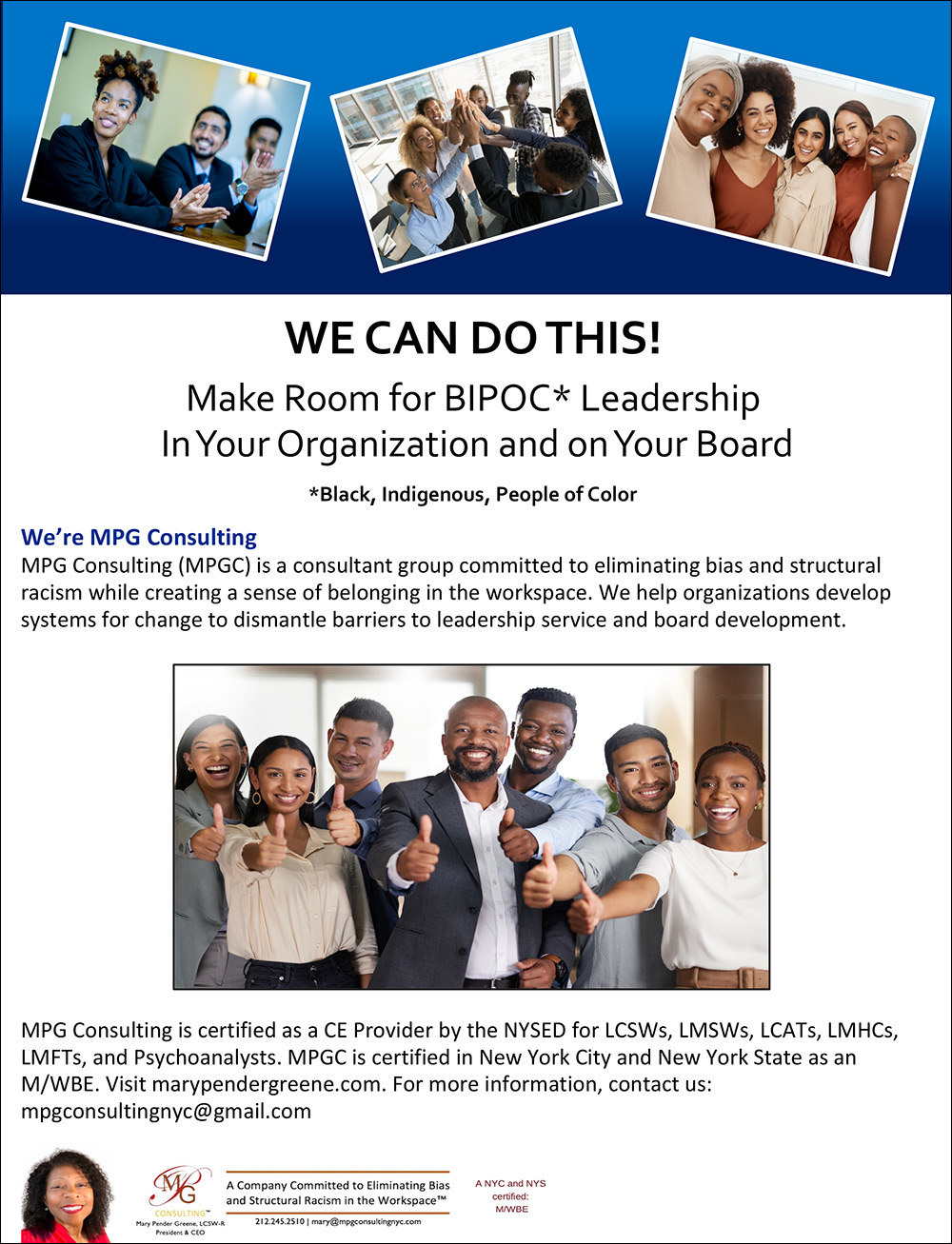Recent research has shown that our collective “mental model” and quest for the conventional white standard for a leader reduces the likelihood that BIPOC will be viewed as suitable for leadership roles. Lack of diversity at the top of organizations has often been attributed to the belief that there are not enough leaders of color in the sector. Our research, data, and personal experiences tells a different story.

Mary Pender Greene, LCSW-R, CGP
We must change the narrative about why there are not more leaders of color in the sector. We need to address how potential leaders of color are “weeded out” on all levels of our institutions based on the deeply held and often unconscious assumptions about race and the perceptions around leadership. We must move away from the presumption that there are not enough qualified individuals who are willing and able to lead. This means looking at the assumptions and structures that guide decision makers. It’s crucial that we turn the mirror inward and become critical lovers of our institutions. This means honestly examining our policies and practices that lead to this leadership gap. Race and race equity can become a top priority in our field when we can begin to talk about how our sector can change its track record on race. We must create the culture shift that is needed to advance the leadership of people of color in the sector.
White institutional culture causes organizations to proclaim that they want diversity and inclusion, yet what they often want is to see difference at the table but not hear or value the lived experience, contributions, or different approaches offered by BIPOC. This failure to accept difference makes it challenging for small numbers of people of color to be authentic, thrive, influence organizational culture or ascend to C-suite levels. Unexamined White favoritism and unimpeded bias and structural racism is a different way of placing a knee on the necks, voices, and contributions of BIPOC along their journey towards leadership. It also nullifies the experience, inspiration, and vision that could be offered by both staff and board members of color.
A leader’s most important role is to set the culture of their organization. Remember that organizational culture is shaped by the worst behavior a leader is willing to tolerate. While workspace diversity is important, culture is equally as important, and often it is not hospitable to people of color in leadership roles. This is the reason why so many BIPOC are overlooked, opt out of leadership paths, or simply leave after a few years. Many who leave claim publicly that it was for a better opportunity, yet privately admit to not feeling valued for who they were and were denied the opportunity to fully contribute.
Belonging As an Integral Part of DEI Initiatives
Leaders on an anti-racist institutional journey must create an atmosphere of inclusiveness and belonging, which tends to produce an environment of collaboration. Prohibition is not the only way to exclude. There are subtle, yet effective methods that can cause BIPOC to be devalued. Belonging goes beyond the concept of DEI to a feeling of being fully accepted and even treasured by their colleagues and the organization. Belongingness is the sense of psychological and emotional well-being that enables people to perform at their best, feel appreciated, respected, and motivated. They can contribute their unique views and ideas. It is also about representation, being seen, and seeing yourself reflected at the highest levels in an organization, and at the decision table. If BIPOC do not see anyone who looks like them in leadership roles, it is harder for them to feel a sense of trust or Belonging.
Creating Safe Spaces
Setting an inclusive work culture of Accountability and Belonging is central to the role of a developing anti-racist leader. An effective culture shift requires the engagement of the entire leadership team. As an antiracist leader, set the tone from the top by evaluating where you are as an organization. Don’t pretend to have a diverse leadership team or board when there are very few BIPOC members. Be aware of who is hired, who gets the plum assignments, who is opting out, who is turning a blind eye, and where the pockets of resistance are. Are some people being treated poorly? Do people feel disconnected? Are people resigning or quiet quitting? Do they feel safe enough to bring their full selves and best selves to work?
Pockets of resistance by staff with positional authority is the greatest threat to an organization’s anti-racist work. Everyone in the organization knows who they are—they are the ones who hold the power to define what and who is good and valued, and yet they are often permitted to opt out of the anti-racist work. When these pockets of resistance are not held accountable, it allows for unchecked white-body privilege, bias, and structural racism. Keep in mind that BIPOC often suppress their authentic thoughts and feelings to survive in white spaces.
Being Accountable
It is the antiracist leader’s role to ensure that antiracist work is not elective. Include every single person working within your organization. Staff with positional power who resist the antiracist goals especially must be held accountable. When certain staff are allowed to opt out of the antiracist work, it is another form of favoritism. A leader’s silence will be viewed as a lack of dedication to the antiracist mission. This inaction is the #1 threat to an organization’s antiracist mission because it causes people inside and outside of the organization to distrust the commitment of leadership.
Repeated microaggressions, subtle insults, witnessing white favoritism, and feeling unvalued can consume tremendous energy. The amount of time that BIPOC are forced to spend on addressing these issues, fighting for job survival, and proving themselves repeatedly causes racial trauma and destroys aspirations. This leads to less-than-optimal performance, success, and retention, followed by low morale and burnout. All leaders’ evaluations should stress the ability to recruit, develop, and maintain a diverse team. Supervisory sessions must include consistent conversations about the status of cross-racial relationships.
Take a bold step and request walking meetings with select BIPOC to learn about their experience at the organization and ask if their BIPOC colleagues are thriving. Walking meetings can strengthen interpersonal relationships since walking side by side means the conversation is more peer-to-peer. This can reduce hierarchical status distinctions and tension during discussions. You can also track the hiring, retention, and promotions of BIPOC staff and check for departmental or supervisory patterns regarding turnover or complaints. You must have zero tolerance for racist or oppressive behavior.
Success lies in holding yourself and the entire organization accountable for the antiracist mission, seeing the value of each team member, and eliminating barriers to the contributions of BIPOC staff. You must become racially literate to be able to see, discuss, and interrupt bias and structural racism. Leadership must consistently demonstrate its commitment to the anti-racist process by setting a tone for honest discourse and openly acknowledging tensions. Friction must be acknowledged and resolved swiftly and respectfully. All staff must be helped to accept a degree of uncertainty and discomfort. Upskill current and potential leaders so they can confidently handle complaints relating to racism and micro-aggressions. The goal is to increase the organization’s tolerance for discomfort.
Checklist for Creating Systems of Support
- Increase your racial literacy. Learn to see how oppression, in its many forms, has led to inequity.
- Listen to the experiences of those most negatively impacted.
- Think outside of the box when reviewing internal talent to further advance IPOC leadership.
- Examine the track record of recruiters; have a conversation about the desire for candidates of color.
- Ask recruiters about their success in finding and placing candidates of color.
- Institute training and hiring standards for people who hire C-suite level staff and Boards of Directors since Boards hire executive leadership. Training should include information on racialized attitudes before a search to lay the groundwork to make decisions to address racial bias.
- Purposefully interact with BIPOC professionals beyond the workspace to develop authentic cross-racial If you have BIPOC in your life and race is not a part of the conversation, the relationship is shallow and inauthentic. Creating a diverse leadership team and board is directly connected to the diversity of your network, so expand it to include BIPOC. Remaining in a silo of white voices limits your ability to meet BIPOC and to have authentic interactions.
- Locate, mentor, and support a BIPOC to be your potential replacement and others for C-suite roles.
An anti-racist journey begins with setting the tone from the top and creating an anti-racist organizational development plan starting with leaders, managers, supervisors, and the board. Since attitude change cannot be mandated, leaders often need support in the form of executive coaching and consultation, as anti-racist work is a messy process. Remember that the overrepresented, presences and voices of White bodied individuals at the top of an institution creates an absence of BIPOC leadership in the system.
MPG Consulting (MPGC) is a consultant group committed to eliminating bias and structural racism while creating a sense of belonging in the workspace. We help organizations develop systems for change to dismantle barriers to success. For more information please visit www.marypendergreene.com, and by email at mary@mpgconsultingnyc.com, (212) 245-2510.







